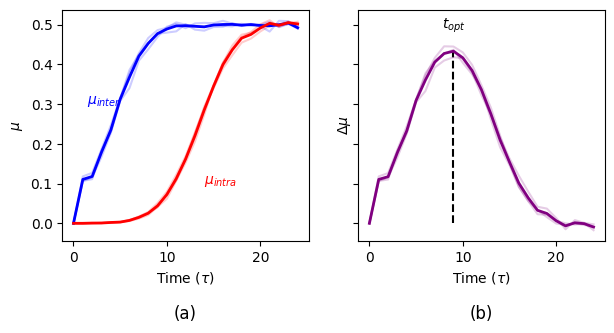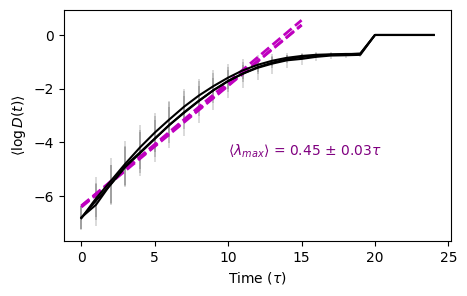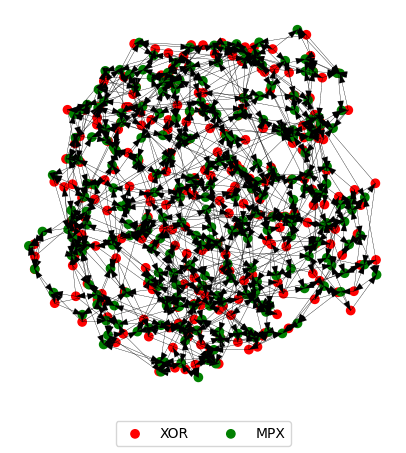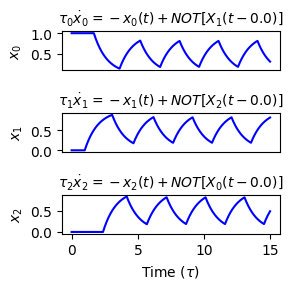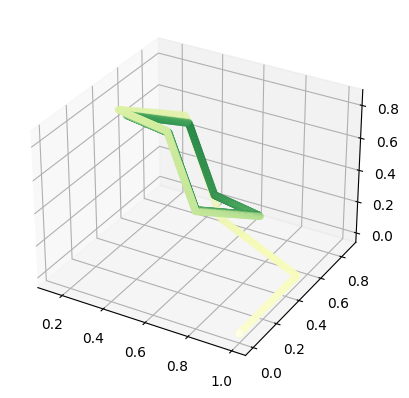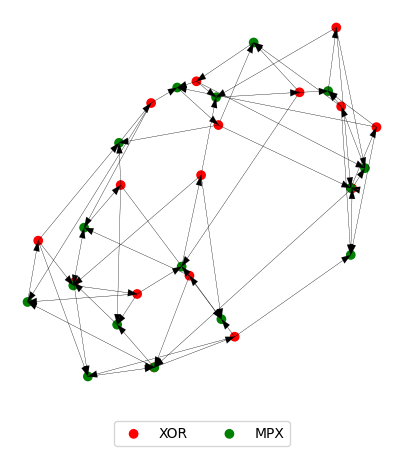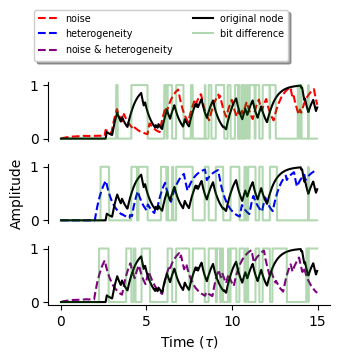Dynamic network models in python.
Project description
networkm
Network Models based on
networkxMultiDiGraph objects endowed with dynamics.Graph Functionscontains various manipulation tools for graph objects.Model Functionscontains methods of simulating these graphs as coupled, time-delayed differential equations with noise, with current support for Boolean functions / Boolean networks.Network Classcontains the culmination of these functions in a singleBooleanNetworkclass object for pipelined analysis.PUF Functionsanalyzes these networks in the context of physically unclonable functions. Accelerated withnumba.
Install
pip install networkm
How to use
import networkm
from networkm import *
This package models Boolean Networks with dynamics of the form
$\tau_{i}\frac{dx_{i}}{dt}=-x_{i}(t)+f_{i}[pred_{i}(t-delays)]+noise$
where tau is a time-constant, f is a logical function, $pred_{i}$ are the nodes flowing into node $x_{i}$ after some time-delay along each edge, and the noise term is random.
We can quickly simulate entire distributions of complex networks and analyze their statistics:
bne=BooleanNetworkEnsemble(classes=3,instances=3,challenges=3,repeats=3,
g = (nx.random_regular_graph,3,256),f=XOR,tau=(rng.normal,1,0.1),a=np.inf,
edge_replacements=dict(a=np.inf,tau=(rng.normal,0.5,0.05),
f=MPX,delay=(rng.random,0,0.5)),
delay=(rng.random,0,1),dt=0.01,T=25,noise=0.01,hold=(rng.normal,1,0.1),
decimation=None)
plot_mu(bne.data)
plot_lya(bne.data)
query : Elapsed time: 7.9315 seconds
bne[0].plot_graph()
Or start more simply, and consider a Ring Oscillator / Repressilator: https://en.wikipedia.org/wiki/Ring_oscillator , https://en.wikipedia.org/wiki/Repressilator. Real-world implications in e.g circuit design and gene-regulatory networks.
The system is a ring of 3 nodes which connect to their left neighbor and cyclically invert eachother.
g=ring(N=3,left=True,right=False,loop=False)
print_graph(g)
|Node|Predecessors|Successors|
|0 |1 |2 |
|1 |2 |0 |
|2 |0 |1 |
We model this with the simplest case, as follows. We give each node the NOT function. This function is executed differentially with a time-constant of 1. The node receives its neighbors state instantly; we put no explicit time-delays along edges, and include no noise. We initialize one node to 1, and hold all nodes at their steady-state value from this configuration for the default value of one time-constant. Then they are released and have the following dynamics:
ro=BooleanNetwork(g=ring(N=3,left=True,right=False,loop=False),
f=NOT,
tau=1,
delay=0,
noise=0,
a=np.inf, #this makes the derivative integer-valued; see `sigmoid` function
init=[1,0,0],
hold=None,
edge_replacements=None,
T=15,
dt=0.01
)
fig_params(reset=True)
ro.plot_timeseries()
The dynamics are not restricted to the edges of a hypercube, allowing Boolean Networks to explore regions of the analog phase space in ways that traditional models forcing only binary valued states don't capture:
ro.plot_3d()
For a more complex example we consider a "Hybrid Boolean Network" composed of a multiplexer - which forces inital conditions using a clock - connected to a chaotic ring network, which executes the XOR function. This has real-world implications in e.g cryptography and physically unclonable functions (PUF) as an HBN-PUF - see https://ieeexplore.ieee.org/document/9380284.
More explicitly, we consider a 16-node ring where each node executes the 3-input XOR function on itself and its two neighbors. We include noise, time-delays, different rise/fall times for tau, and replace each node with itself + a multiplexer that sets the initial condition and copies the state thereafter, with its own set of dynamical constants.
b=BooleanNetwork(g = nx.random_regular_graph(3,16),
a = (rng.normal,15,5),
tau = (rng.normal,[0.5,0.4],[0.1,0.05]),
f = XOR,
delay = (rng.random,0,1),
edge_replacements = dict(
delay = (rng.normal,0.5,0.1),
a = (rng.normal,15,5),
tau = (rng.normal,[0.2,0.15],[0.05,0.05]),
f = MPX
),
T = 15,
dt = 0.01,
noise = 0.01,
init = None,
hold = None,
plot=False,
)
b.plot_graph()
We can quickly analyze differences between e.g randomly shuffled attributes and noise:
chal=b.random_init()
x,x0,y,y0=b.integrate(init=chal,noise=0.),\
b.integrate(init=chal,noise=0.1),\
b.query(instances=1,challenges=[chal],repeats=1,noise=0)[0,0,0],\
b.integrate(noise=0.1) #parameters been shuffled by query
plot_comparison(x,x0,y,y0,i=0)
sidis.refresh()
Project details
Release history Release notifications | RSS feed
Download files
Download the file for your platform. If you're not sure which to choose, learn more about installing packages.


